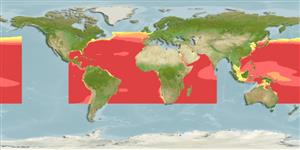Common names from other countries
>
Stomiiformes (Lightfishes and dragonfishes) >
Stomiidae (Barbeled dragonfishes) > Melanostomiinae
Etymology: Eustomias: Greek, eu = good + Greek, stoma = mouth (Ref. 45335).
Environment: milieu / climate zone / depth range / distribution range
Ecologia
marinhas; intervalo de profundidade 20 - ? m (Ref. 58018). Deep-water; 52°N - 34°S, 98°W - 154°W
Atlantic Ocean: roughly between 35°N and 27°S. Eastern Central Pacific: near Hawaii and just south of the equator. Western Central Pacific: several stations north of the equator. Also known from the Western Indian Ocean.
Comprimento de primeira maturação / Tamanho / Peso / Idade
Maturity: Lm 11.0, range 10 - 11.7 cm
Max length : 19.3 cm SL macho/indeterminado; (Ref. 4468)
Barbel with a single-based branch arising from stem; a pair of bifurcate lateral branches arising from medial branch well distal to its origin; medial branch prominent and extending well beyond origin of laterals, with a small bulblet at distal end; terminal bulb with both medial and laterally paired, relatively simple terminal filaments, their lengths less than 50% of distal barbel.
Mesopelagic (Ref. 27000). Also Ref. 58302.
Ciclo de vida ou comportamento de acasalamento
Maturities | Reprodução | Spawnings | Egg(s) | Fecundities | Larvas
Gibbs, R.H. and M.A. Barnett, 1990. Melanostomiidae. p. 308-337. In J.C. Quero, J.C. Hureau, C. Karrer, A. Post and L. Saldanha (eds.) Check-list of the fishes of the eastern tropical Atlantic (CLOFETA). JNICT, Lisbon; SEI, Paris; and UNESCO, Paris. Vol. 1. (Ref. 4468)
Status na Lista Vermelha da UICN (Ref. 130435)
CITES (Ref. 128078)
Not Evaluated
Ameaça para os humanos
Harmless
Uso pelos humanos
Pescarias: sem interesse
Ferramentas
Relatórios especiais
Baixar XML
Fontes da internet
Estimates based on models
Preferred temperature (Ref.
115969): 8.8 - 21, mean 13.9 (based on 838 cells).
Índice de diversidade filogenética (Ref.
82804): PD
50 = 0.5000 [Uniqueness, from 0.5 = low to 2.0 = high].
Bayesian length-weight: a=0.00302 (0.00117 - 0.00783), b=3.12 (2.89 - 3.35), in cm Total Length, based on LWR estimates for this (Sub)family-body shape (Ref.
93245).
Nível Trófico (Ref.
69278): 4.2 ±0.73 se; based on food items.
Resiliência (Ref.
120179): médio(a), tempo mínimo de duplicação da população 1,4 - 4,4 anos (Preliminary K or Fecundity.).
Fishing Vulnerability (Ref.
59153): Low vulnerability (14 of 100).
